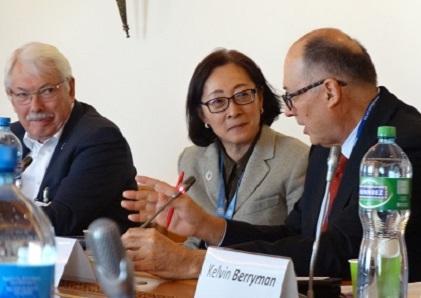
(from left) At the GAR Advisory Board meeting in Geneva yesterday, Peter Head, Ecological Sequestration Unit, Mami Mizutori, head of UNISDR, and Ricardo Mena, Chief, Sendai Framework Implementation Branch, UNISDR
By Brigitte Leoni
GENEVA, 21 March 2018 - A new Advisory Board convened yesterday to discuss the direction and content of the 2019 edition of the Global Assessment Report for Disaster Risk Reduction (GAR19), the UN flagship publication which first appeared in 2009.
The GAR is a comprehensive review and analysis of disaster risk and risk management published every two years. The last full GAR edition was launched in March 2015 at the Third World Conference on Disaster Risk Reduction in Sendai, Japan and looked at how to make development sustainable. In 2017, the GAR Risk Atlas was launched at the Global Platform for Disaster Risk Reduction in Cancun, Mexico.
“This first meeting of the GAR Advisory Board marks the beginning of the next phase in the development of the GAR process,” said Mami Mizutori UN Special Representative of the Secretary-General for Disaster Risk Reduction on opening the meeting with 22 experts from multiple disciplines.
“The GAR will not only assess the status of global disaster risk but also what it means for the implementation of the Sustainable Development Goals,” she said, emphasizing that ‘no development will be sustainable if it is not risk informed.”
The GAR will detail the progress made by countries on the implementation of Sendai Framework for Disaster Risk Reduction 2015-2030, the global plan for reducing disaster losses including substantial reductions in mortality, numbers of people affected, economic losses and damage to critical infrastructure.
One chapter will be devoted to global Target (e) of the Sendai Framework which aims to “substantially increase the number of countries with national and local disaster risk reduction strategies by 2020.”
Other topics that will be covered relate to the progress on the development of a Global Risk Assessment Framework and an introduction to man-made hazards and related environmental, technological and biological hazards that were included in expanded scope of hazards defined by the Sendai Framework.